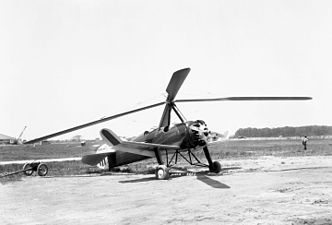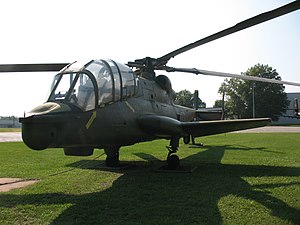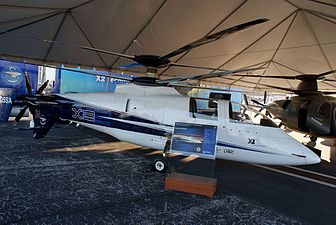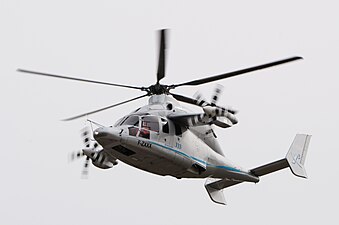Slowed rotor

The McDonnell XV-1 could slow its rotor from 410 to 180 RPM
Slowed rotor is a concept in designing and flying certain rotorcraft. Reducing the rotational speed of the rotor reduces the drag, enabling the aircraft to go faster and/or fly more economically.
Contents
1 Background
2 Theory
3 Aircraft
4 List of slowed rotor aircraft
5 See also
6 References
6.1 Notes
6.2 Citations
6.3 Bibliography
7 External links
Background
Rotors of conventional helicopters are designed to operate at a fixed RPM[1][2][3] (within just a few percent),[4][5][6] causing suboptimal operation in large parts of the flight envelope.[7]
Two main issues restrict the speed of rotorcraft:[6][8][9][10]
Retreating blade stall. As forward speed of the helicopter increases, the airflow over the retreating blade becomes relatively slower, while the airflow over the advancing blade is relatively faster, creating more lift. If not counteracted by flapping,[11] this would cause dissymmetry of lift and eventually retreating blade stall,[12][13][14][15][16] and blade stability suffers as the blade reaches its limits for flapping.[10][17]
Transonic drag near the rotor blade tip. The faster-moving advancing blade tip may begin to approach the speed of sound, where transonic drag begins to rise steeply, and severe buffeting and vibration effects can occur. This effect prevents any further increase in speed, even if the helicopter has surplus power remaining, and even if it features a highly streamlined fuselage. A similar effect prevents propeller-driven aircraft from achieving supersonic speeds, although they can achieve higher speeds than a helicopter, since the propeller blade isn't advancing in the direction of travel.[12][13][16][18][19][20]
These (and other)[21][22] problems limit the practical speed of helicopters to around 160–200 knots (300–370 km/h).[16][20][23][24][25] At the extreme, the theoretical top speed for a rotary winged aircraft is about 225 knots (259 mph; 417 km/h),[22] just above the current official speed record for a conventional helicopter held by a Westland Lynx, which flew at 400 km/h (250 mph) in 1986[26] where its blade tips were nearly Mach 1.[27]
Theory

Rotorcraft Aspect ratio (mu) diagram
For rotorcraft, advance ratio (or Mu, symbol μ{displaystyle mu }
The "relative blade tip speed" u is the tip speed relative to the aircraft (not the airspeed of the tip). Thus the formula for Advance ratio is
μ=Vu=VΩ⋅R{displaystyle mu ={frac {V}{u}}={frac {V}{Omega cdot R}}}

Effect of blade airspeed on lift on advancing and retreating side, when aircraft speed is 100 knots.
When the rotor blade is perpendicular to the aircraft and advancing, its tip airspeed Vt is the aircraft speed plus relative blade tip speed, or Vt=V+u.[10][33] At mu=1, V is equal to u and the tip airspeed is twice the aircraft speed.
At the same position on the opposite side (retreating blade), the tip airspeed is the aircraft speed minus relative blade tip speed, or Vt=V-u. At mu=1, the tip airspeed is zero.[25][34] At a mu between 0.7 and 1.0, most of the retreating side has reverse airflow.[32]

Drag type curves as a function of airspeed (simulated)
Although rotor characteristics are fundamental to rotorcraft performance,[35] little public analytical and experimental knowledge exists between advance ratios of 0.45 to 1.0,[32][36] and none is known above 1.0 for full-size rotors.[37][38]Computer simulations are not capable of adequate predictions at high mu.[39][40] The region of reverse flow on the retreating blade is not well understood,[41][42] however some research have been conducted,[43][44] particularly for scaled rotors.[45][46] The US Army Aviation Applied Technology Directorate runs a supporting program in 2016 aiming at developing transmissions with a 50% rotor speed reduction.[47]
The profile drag of a rotor corresponds to the cube of its rotational speed.[48][49]
Reducing the rotational speed is therefore a significant reduction of rotor drag, allowing higher aircraft speed[32] or lower power consumption.[7] A conventional rotor such as the UH-60A has lowest consumption around 75% rpm, but higher aircraft speed (and weight) requires higher rpm.[50]
A rotor disk with variable radius is a different way of reducing tip speed to avoid compressibility, but blade loading theory suggests that a fixed radius with varying rpm performs better than a fixed rpm with varying radius.[51]
Aircraft
Traditional helicopters get both their propulsion and lift from the main rotor, and by using a dedicated propulsion device such as a propeller or jet engine, the rotor burden is lessened.[16]
If wings are also used to lift the aircraft, the rotor can be unloaded (partially or fully) and its rotational speed further reduced, enabling higher aircraft speed. Compound helicopters use these methods,[12][13][23][8] but the Boeing A160 Hummingbird shows that rotor-slowing is possible without wings or propellers, and regular helicopters may reduce turbine RPM (and thus rotor speed) to 85% using 19% less power.[7] Alternatively, research suggests that twin-engine helicopters may decrease consumption by 25%-40% when running only one engine, given adequate height and velocity well inside the safe areas of the height–velocity diagram.[52][53][54]
As of 2012, no compound or hybrid wing/rotor (manned) aircraft has been produced in quantity, and only a few have been flown as experimental aircraft,[55] mainly because the increased complexities have not been justified by military or civilian markets.[56] Varying the rotor speed may induce severe vibrations at specific resonance frequencies.[6]
Contra-rotating rotors like on Sikorsky X2 solve the problem of lift dissymmetry by having both left and right sides provide near equal lift with less flapping.[10][16] The X2 deals with the compressibility issue by reducing its rotor speed[16] from 446 to 360 RPM[32][57] to keep the advancing blade tip below the sound barrier when going above 200 knots.[58]
List of slowed rotor aircraft
Sorted by year. Click <> to sort by other parameters.
| Year | Aircraft | Type | Speed | Mu | Rotor RPM | Wing Rotor lift[N 1] | L/D[N 2] |
|---|---|---|---|---|---|---|---|
| 1932 | Pitcairn PCA-2 | Winged autogyro | 20-102 knots (117 mph; 189 km/h)[59] | 0.7[60] | 4.8[61] | ||
| 1955 | McDonnell XV-1 | Tip-jet autogyro | 170 knots (200 mph; 310 km/h) | 0.95[62] | 180-410[63] (50%[64]) | 85% 15% [65] | 6.5[N 3] |
| 1959 | Fairey Rotodyne | Tip-jet gyrodyne | 166 knots (191 mph; 307 km/h)[67][68] | 0.6[69] | 120 to 140[70] | 60% 40% [71] | |
| 1969 | Lockheed AH-56 Cheyenne | Compound helicopter | 212 knots (244 mph; 393 km/h)[72][73] | 0.8[62] | .. 20% [74] | ||
| 1969 | Bell 533 | Compound jet helicopter | 275 knots (316 mph; 509 km/h)[75][76] | ||||
| 2005 | CarterCopter | Winged autogyro | 150 knots (170 mph; 280 km/h)[77] | 1 | 50%[32] | ||
| 2007 | Boeing A160 Hummingbird | Unmanned helicopter | 140 knots (160 mph; 260 km/h) | 140 to 350[78] | No wings or propeller | ||
| 2010 | Sikorsky X2 | Helicopter with coaxial rotors | 250 knots (290 mph; 460 km/h)[79][80] | 0.8[32] | 360 to 446[32][57] | No wings [81] | |
| 2013 | Eurocopter X3[82] | Compound helicopter | 255 knots (293 mph; 472 km/h)[83][84] | 310 minus 15%[10] | 40[10][16]-80% .[85][86] | ||
| 2013 | Carter PAV | Winged autogyro | 175 knots (201 mph; 324 km/h) | 1.13 | 105[87] to 350[88] | ||
| For comparison : | |||||||
| 1986 | Westland Lynx | Helicopter | 216 knots (249 mph; 400 km/h)[26] | 318[89] | 2[90] | ||
| 20xx | Bell Boeing V-22 Osprey | Tiltrotor | 275[91]-305 knots[92] | 84% to 100%[93][N 4] or 333 to 412 RPM[32] | 4.5[93] |
^ Rotorlift is the lift provided by the rotor as a percentage of total lift, at full speed.
^ L/D is Lift-to-drag ratio; a measure of flight efficiency.
^ Wind tunnel tests at 180 RPM with no propeller.[66]
^ Like the V-22, the AgustaWestland AW609 tiltrotor also reduces its proprotor RPM from 100% to 84% after converting from hover to cruise.[94]
- Visual comparison of slowed rotor aircraft

Venn diagram of cruise combinations for rotor power, propeller and wings.

Pitcairn PCA-2
Unpowered rotor, tractor propeller, wings.

McDonnell XV-1
Optionally powered rotor, pusher propeller, wings.

Fairey Rotodyne
Optionally powered rotor, tractor propellers, wings.

Lockheed AH-56 Cheyenne
Powered rotor, pusher propeller, wings.

Bell 533
Powered rotor, jets, wings.

Boeing A160 Hummingbird
No wings, no propeller.

Sikorsky X2
Powered rotor, pusher propeller, no wings.

Eurocopter X3
Powered rotor, tractor propellers, wings.

Carter PAV
Unpowered rotor, pusher propeller, wings.
See also
- Gyrodyne
- Convertiplane
References
Notes
Citations
^ Croucher 2008, page 2-12. Quote: [Rotor speed] "is constant in a helicopter".
^ Seddon 2011, p216. Quote: The rotor is best served by rotating at a constant rotor speed
^ Robert Beckhusen. "Army Dumps All-Seeing Chopper Drone" Wired June 25, 2012. Accessed: 12 October 2013. Quote: for standard choppers .. the number of revolutions per minute is also set at a fixed rate
^ The UH-60 permits 95–101% rotor RPM UH-60 limits US Army Aviation. Retrieved 2 January 2010
^ Trimble, Stephen (3 July 2008). "DARPA's Hummingbird unmanned helicopter comes of age". FlightGlobal. Archived from the original on 14 May 2014. Retrieved 14 May 2014.The rotor speed on a typical helicopter can be varied around 95-102%
.mw-parser-output cite.citation{font-style:inherit}.mw-parser-output .citation q{quotes:"""""""'""'"}.mw-parser-output .citation .cs1-lock-free a{background:url("//upload.wikimedia.org/wikipedia/commons/thumb/6/65/Lock-green.svg/9px-Lock-green.svg.png")no-repeat;background-position:right .1em center}.mw-parser-output .citation .cs1-lock-limited a,.mw-parser-output .citation .cs1-lock-registration a{background:url("//upload.wikimedia.org/wikipedia/commons/thumb/d/d6/Lock-gray-alt-2.svg/9px-Lock-gray-alt-2.svg.png")no-repeat;background-position:right .1em center}.mw-parser-output .citation .cs1-lock-subscription a{background:url("//upload.wikimedia.org/wikipedia/commons/thumb/a/aa/Lock-red-alt-2.svg/9px-Lock-red-alt-2.svg.png")no-repeat;background-position:right .1em center}.mw-parser-output .cs1-subscription,.mw-parser-output .cs1-registration{color:#555}.mw-parser-output .cs1-subscription span,.mw-parser-output .cs1-registration span{border-bottom:1px dotted;cursor:help}.mw-parser-output .cs1-ws-icon a{background:url("//upload.wikimedia.org/wikipedia/commons/thumb/4/4c/Wikisource-logo.svg/12px-Wikisource-logo.svg.png")no-repeat;background-position:right .1em center}.mw-parser-output code.cs1-code{color:inherit;background:inherit;border:inherit;padding:inherit}.mw-parser-output .cs1-hidden-error{display:none;font-size:100%}.mw-parser-output .cs1-visible-error{font-size:100%}.mw-parser-output .cs1-maint{display:none;color:#33aa33;margin-left:0.3em}.mw-parser-output .cs1-subscription,.mw-parser-output .cs1-registration,.mw-parser-output .cs1-format{font-size:95%}.mw-parser-output .cs1-kern-left,.mw-parser-output .cs1-kern-wl-left{padding-left:0.2em}.mw-parser-output .cs1-kern-right,.mw-parser-output .cs1-kern-wl-right{padding-right:0.2em}
^ abc Lombardi, Frank. "Optimizing the Rotor" Rotor&Wing, June 2014. Accessed: 15 June 2014. Archived on 15 June 2014
^ abc Khoshlahjeh
^ abc Harris 2003, page 7
^ Chiles, James R. "Hot-Rod Helicopters" Page 2 Page 3 Air & Space/Smithsonian, September 2009. Accessed: 18 May 2014.
^ abcdef Nelms, Douglas. "Aviation Week Flies Eurocopter’s X3" Aviation Week & Space Technology, 9 July 2012. Accessed: 10 May 2014. Alternate link Archived on 12 May 2014
^ "Blade flapping" Dynamic Flight
^ abc Robb 2006, page 31
^ abc Silva 2010, page 1.
^ "Helicopter Limitations" Challis Heliplane
^ "Retreating blade stall" Dynamic Flight
^ abcdefg Chandler, Jay. "Advanced rotor designs break conventional helicopter speed restrictions (page 1) Archived 2013-07-18 at the Wayback Machine" Page 2 Archived 2013-07-18 at the Wayback Machine Page 3 Archived 2013-07-18 at the Wayback Machine. ProPilotMag, September 2012. Accessed: 10 May 2014. Archive 1 Archive 2 Archive 3
^ abc Johnson HT, p. 323
^ Prouty, Ray. "Ask Ray Prouty" Rotor&Wing, 1 May 2005. Accessed: 18 May 2014.
^ "Nomenclature: Transonic drag rise" NASA
^ abc Filippone, Antonio (2000). "Data and performances of selected aircraft and rotorcraft" pages 643-646. Department of Energy Engineering, Technical University of Denmark / Progress in Aerospace Sciences, Volume 36, Issue 8. Accessed: 21 May 2014. doi:10.1016/S0376-0421(00)00011-7 Abstract
^ Beare, Glenn. "Why can't a Helicopter fly faster than it does ?" helis.com . Accessed: 9 May 2014.
^ ab Krasner, Helen. "Why Can’t Helicopters Fly Fast?" Decoded Science, 10 December 2012. Accessed: 9 May 2014.
^ ab Clean Sky 2012, page 44
^ Majumdar, Dave. "DARPA Awards Contracts in Search of a 460 MPH Helicopter" United States Naval Institute, 19 March 2014. Accessed: 9 May 2014.
^ ab Wise, Jeff. "The Rise of Radical New Rotorcraft" Popular Mechanics, 3 June 2014. Accessed: 19 June 2014. Archive Quote: "This aerodynamic principle limits conventional helicopters to about 200 mph."
^ ab "Rotorcraft Absolute: Speed over a straight 15/25 km course Archived 2013-12-03 at the Wayback Machine". Fédération Aéronautique Internationale (FAI). Note search under E-1 Helicopters and "Speed over a straight 15/25 km course". Accessed: 26 April 2014.
^ Hopkins, Harry (27 December 1986), "Fastest blades in the world" (pdf), Flight International: 24–27, retrieved 28 April 2014,Archive page 24 Archive page 25 Archive page 26 Archive page 27
^ "Nomenclature: Mu" NASA
^ Definition of Advance ratio
^ "Flapping Hinges" Aerospaceweb.org. Accessed: 8 May 2014.
^ Jackson, Dave. "Tip Speed Ratio (Advance Ratio)" Unicopter, 6 September 2013. Retrieved: 22 May 2015. Archived on 21 October 2014.
^ abcdefghi Datta, page 2.
^ "Helicopter Flying Handbook", Chapter 02: Aerodynamics of Flight (PDF, 9.01 MB), Figure 2-33 page 2-18. FAA-H-8083-21A, 2012. Accessed: 21 May 2014.
^ Berry, page 3-4
^ Harris 2008, page 13
^ Berry, page 25
^ Harris 2008, page 25
^ Kottapalli, page 1
^ Harris 2008, page 8
^ Bowen-Davies, page 189-190
^ Harris 2008, page 14
^ Bowen-Davies, page 198
^ DuBois 2013
^ Potsdam, Mark; Datta, Anubhav; Jayaraman, Buvana (18 March 2016). "Computational Investigation and Fundamental Understanding of a Slowed UH-60A Rotor at High Advance Ratios". AHS International. doi:10.4050/JAHS.61.022002. Archived from the original on 2016-03-27. Retrieved 27 March 2016.
^ Bowen-Davies, page 216
^ Granlund, Kenneth; Ol, Michael; Jones, Anya. "Streamwise oscillation of airfoils into reverse-flow". AIAA. doi:10.2514/1.J054674.
^ Renata Y. Ellington & Laurie Pierce (21 March 2016). "Contract Activity: Next Generation Rotorcraft Transmission (NGRT)". Aviation Applied Technology Directorate. GovTribe. Archived from the original on 27 March 2016. Retrieved 27 March 2016.
^ Gustafson, page 12
^ Johnson RA, page 251.
^ Bowen-Davies, page 97-99
^ Bowen-Davies, page 101
^ Dubois, Thierry. "Researchers Look at Single-engine Cruise Ops on Twins" AINonline, 14 February 2015. Accessed: 19 February 2015.
^ Perry, Dominic. "Airbus Helicopters promises safe single-engine operations with Bluecopter demonstrator" Flight Global, 8 July 2015. Archive
^ Perry, Dominic. "Turbomeca eyes flight tests of 'engine sleep mode'" Flight Global, 25 September 2015. Archive
^ Rigsby, page 3
^ Johnson HT, p. 325
^ ab Jackson, Dave. "Coaxial - Sikorsky ~ X2 TD" Unicopter. Accessed: April 2014.
^ Walsh 2011, page 3
^ Harris 2003, page A-40
^ Harris 2008, page 19
^ Duda, Holger; Insa Pruter (2012). "Flight performance of lightweight gyroplanes" (PDF). German Aerospace Center. p. 5. Retrieved April 2014. Check date values in:|accessdate=(help)
[permanent dead link]
^ ab Anderson, Rod. "The CarterCopter and its legacy" Issue 83, Contact Magazine, 30 March 2006. Accessed: 11 December 2010. Mirror
^ Harris 2003, page 14
^ Watkinson, page 355
^ Robb 2006, page 41
^ Harris 2003, page 18. Lift forces at page A-101
^ "FAI Record ID #13216 - Rotodyne, Speed over a closed circuit of 100 km without payload Archived 2015-02-17 at the Wayback Machine" Fédération Aéronautique Internationale. Record date 5 January 1959. Accessed: April 2014.
^ Anders, Frank. (1988) "The Fairey Rotodyne" (excerpt) Gyrodyne Technology (Groen Brothers Aviation). Retrieved: 17 January 2011. Archived 26 February 2014
^ Rigsby, page 4
^ "Requiem for the Rotodyne." Flight International, 9 August 1962, pp. 200–202.
^ Braas, Nico. "Fairey Rotodyne" Let Let Let Warplanes, 15 June 2008. Accessed: April 2014. Archived on 30 September 2013
^ Landis and Jenkins 2000, pp. 41–48.
^ "AH-56A Cheyenne" Globalsecurity.org. Accessed: April 2014.
^ Harris? not 2008, not Vol1+2, page 119
^ Robb 2006, page 43
^ Spenser, Jay P. "Bell Helicopter". Whirlybirds, A History of the U.S. Helicopter Pioneers, p. 274. University of Washington Press, 1998.
ISBN 0-295-98058-3.
^ Wise, Jeff. "Jay Carter, Jr." Popular Science, 2005. Magazine
^ Hambling, David. "The Rise of the Drone Helicopter - A160T Hummingbird" Popular Mechanics. Accessed: April 2014.
^ Croft, John (15 September 2010). "Sikorsky X2 hits 250kt goal". Flight International. Archived from the original on 17 January 2011. Retrieved 15 September 2010.
^ Goodier, Rob (September 20, 2010). "Inside Sikorsky's Speed-Record-Breaking Helicopter Technology". Popular Mechanics. Retrieved 22 September 2010.
^ D. Walsh, S. Weiner, K. Arifian, T. Lawrence, M. Wilson, T. Millott and R. Blackwell. "High Airspeed Testing of the Sikorsky X2 Technology Demonstrator" Sikorsky, May 4, 2011. Accessed: October 5, 2013.
^ The X3 concept Archived 2014-05-12 at the Wayback Machine Video1 Video2, at 2m50s Airbus Helicopters. Accessed: 9 May 2014.
^ Thivent, Viviane. "Le X3, un hélico à 472 km/h" Le Monde, 11 June 2013. Accessed: 10 May 2014. Possible mirror
^ X3 Helicopter Sets Speed Record At Nearly 300 MPH Wired
^ Norris, Guy. "Eurocopter X-3 Targets U.S. Market[permanent dead link]" Aviation Week, 28 February 2012. Accessed: 1 March 2012. Mirror
^ Tarantola, Andrew. "Monster Machines: The New Fastest Helicopter On Earth Can Fly At An Insane 480km/h" Gizmodo, 19 June 2013. Accessed: April 2014.
^ Warwick, Graham. "Carter Hopes To Demo SR/C Rotorcraft To Military" Aviation Week, 5 February 2014. Accessed: 19 May 2014. Archived on 19 May 2014
^ Moore, Jim. "Carter seeks factory" Aircraft Owners and Pilots Association, 21 May 2015. Accessed: 28 May 2014. Archived on 22 May 2015.
^ Watkinson 2004, page 108
^ Harris 2008, page 20
^ Wall, Robert. "U.S. Marines See MV-22 Improvements."[permanent dead link]Aviation Week, 24 June 2010.
^ Norton, Bill. Bell Boeing V-22 Osprey, Tiltrotor Tactical Transport, page 111. Earl Shilton, Leicester, UK: Midland Publishing, 2004.
ISBN 1-85780-165-2.
^ ab McKinney, Mike. "Flying the V-22" Vertical, 28 March 2012. Retrieved: 29 April 2014. Archived on 30 April 2014
^ Head, Elan (20 January 2014). "Flying the AW609: A Preview". Vertical. Archived from the original on 25 April 2014. Retrieved 20 January 2014.
Bibliography
.mw-parser-output .refbegin{font-size:90%;margin-bottom:0.5em}.mw-parser-output .refbegin-hanging-indents>ul{list-style-type:none;margin-left:0}.mw-parser-output .refbegin-hanging-indents>ul>li,.mw-parser-output .refbegin-hanging-indents>dl>dd{margin-left:0;padding-left:3.2em;text-indent:-3.2em;list-style:none}.mw-parser-output .refbegin-100{font-size:100%}
- Berry, Ben & Chopra, Inderjit. Slowed Rotor Wind Tunnel Testing at UMD University of Maryland, 19 February 2014. Size: 3MB. Archive
- Bowen-Davies, Graham M. Performance and loads of variable tip speed rotorcraft at high advance ratios (dissertation) University of Maryland, 25 June 2015. Header. DOI:10.13016/M2N62C . Size: 313 pages in 7MB
- Croucher, Phil. Professional helicopter pilot studies
ISBN 978-0-9780269-0-5
- Datta, Anubhav et al. (2011). Experimental Investigation and Fundamental Understanding of a Slowed UH-60A Rotor at High Advance Ratios NASA ARC-E-DAA-TN3233, 2011. Header Accessed: April 2014. Size: 26 pages in 2MB
- DuBois, Cameron J. (2013). Flow Control on an Airfoil Under Reversed Flow Conditions Using Nanosecond Dielectric Barrier Discharge Actuators (dissertation abstract) Ohio State University. Accessed: 4 December 2014. Size: 86 pages in 6MB
- Floros, Matthew W. & Wayne Johnson (2004). Stability Analysis of the Slowed-Rotor Compound Helicopter Configuration (1MB). Defense Technical Information Center, 2004. Alternate version, 8MB
- Gustafson, F. B. Effect on helicopter performance of modifications in profile-drag characteristics of rotor-blade airfoil sections NACA, August 1944.
- Harris, Franklin D. (2003). An Overview of Autogyros and the McDonnell XV–1 Convertiplane NASA/CR—2003–212799, 2003. Header Mirror1, Mirror2. Size: 284 pages in 13MB
- Harris, Franklin D. (2008). Rotor Performance at High Advance Ratio: Theory versus Test NASA/CR—2008–215370, October 2008. Header Mirror. Accessed: 13 April 2014. Size: 521 pages in 5MB
Johnson, Wayne (2012). Helicopter Theory. Courier Corporation. p. 323. ISBN 978-0-486-13182-5.
Johnson, Wayne (2013). Rotorcraft Aeromechanics. Cambridge University Press. ISBN 978-1-107-02807-4.
- Khoshlahjeh, Maryam & Gandhi, Farhan (2013). Helicopter Rotor Performance Improvement with RPM Variation and Chord Extension Morphing American Helicopter Society. Accessed: 9 June 2014.
- Kottapalli, Sesi et al. (2012). Performance and loads correlation of a UH-60A slowed rotor at high advance ratios NASA ARC-E-DAA-TN4610, June 2012. Header Size: 30 pages in 2MB
- Landis, Tony and Jenkins, Dennis R. Lockheed AH-56A Cheyenne – WarbirdTech Volume 27, Specialty Press, 2000.
ISBN 1-58007-027-2. - Rigsby, James Michael (2008). Stability and control issues associated with lightly loaded rotors autorotating in high advance ratio flight (dissertation abstract) Georgia Institute of Technology, December 2008. Size: 166 pages in 3MB
- Robb, Raymond L. (2006). Hybrid helicopters: Compounding the quest for speed, Vertiflite. Summer 2006. American Helicopter Society. Size: 25 pages in 2MB
- Seddon, John M. (& Simon Newman). Basic Helicopter Aerodynamics John Wiley and Sons, 2011.
ISBN 1-119-99410-1
- Silva, Christopher ; Yeo, Hyeonsoo ; Johnson, Wayne. (2010) Design of a Slowed-Rotor Compound Helicopter for Future Joint Service Missions NASA ADA529322. Mirror Size: 17 pages in 4MB
- D. Walsh, S. Weiner, K. Arifian, T. Lawrence, M. Wilson, T. Millott and R. Blackwell. High Airspeed Testing of the Sikorsky X2 Technology Demonstrator Sikorsky, May 4, 2011. Accessed: October 5, 2013. Size: 12 pages in 3MB
Watkinson, John (2004). The Art of the Helicopter. Elsevier Butterworth-Heinemann. ISBN 07506 5715 4.
Clean Sky 2: "A Preliminary Programme Outline For Clean Sky 2", July 2012. Size 2MB









